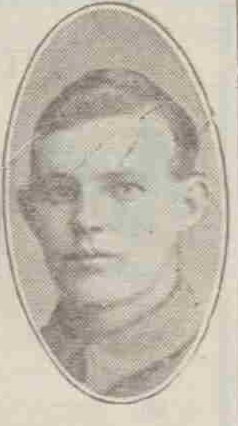Pte
Maxwell McKnight Parker
Information about birth
|
Date of birth: 28/05/1898 |
|
Place of birth: Tinwald, Dumfriesshire, Scotland, United Kingdom |
General information
|
Last known residence: Leithenhall Dumfriesshire, Scotland, United Kingdom |
|
Profession: Station Hand - Farm Hand |
|
Religion: Presbyterian |
Army information
|
Country: Scotland, United Kingdom |
|
Force: British Expeditionary Force |
|
Rank: Private |
|
Service number: 40918 |
|
Enlistment date: 11/05/1916 |
|
Enlistment place: Berwick-upon-Tweed, Northumberland, England, United Kingdom |
|
Units: — Royal Scots Fusiliers, 1st Bn. (Last known unit) — King's Own Scottish Borderers, 9th Bn. |
Information about death
|
Date of death: 26/09/1917 |
|
Place of death: Hill 40, Zonnebeke, Belgium |
|
Cause of death: Killed in action (K.I.A.) |
|
Age: 19 |
Memorial
|
Tyne Cot Memorial Panel: 61 A |
Distinctions and medals 2
|
British War Medal Medal |
|
Victory Medal Medal |
Points of interest 4
| #1 | Place of birth | ||
| #2 | Last known residence | ||
| #3 | Enlistment place | ||
| #4 | Place of death (approximate) |
My story
Maxwell McKnight Parker was born on 28 May 1898 at Belzies Cottage near Tinwald, Dumfriesshire in Scotland. When Maxwell enlisted, he lived with his parents in Leithenhall, Wamphray, Dumfriesshire, and worked as a farmhand. Maxwell was not yet 18 when he enlisted in December 1915. As he was not yet of age, he was posted to the army reserve at home and was not mobilised until May 1916. Maxwell was posted to the King's Own Scottish Borderers and eventually transferred to the Royal Scots Fusiliers, 1st Battalion, 8th Brigade of the 3rd Division, who fought in the Battle of Polygon Wood (26 September - 3 October 1917), a phase of the Battle of Passchendaele.
On 26 September 1917, the 3rd Division attacked the ruins of Zonnebeke with the 8th Brigade and the 76th Brigade, the Ypres-Roulers railway acting as a boundary between the two Brigades. Hill 40, along the Langemark-Zonnebeke road, was the 8th Brigade's final objective. The attack began at 5.30 am. The 2nd Royal Scots and the 8th East Yorks led the advance, while the 1st Royal Scots Fusiliers and the 7th King's Shropshire Light Infantry provided support. The 2nd Scots, with their right flank on the railway, took the first objective, which ran from Van Isackere Farm, across the railway and past St Joseph’s Institute in Zonnebeke. Once the first objective was consolidated, the 1st Royal Scots and the 7th KSLI advanced to the western slopes of Hill 40, just before the second objective. The Royal Scots were held up by an impassable swamp and, having to bypass it, lost time and the protection of the artillery barrage. As they regrouped on the other side, German machine guns opened fire on them from Hill 40. An unsuccessful attempt to take the heights was made at 6.30pm and heavy fighting and several German counterattacks took place. The 1st Royal Scots were forced to dig in 200 metres west of Hill 40. German artillery remained active throughout the day and regularly shelled the positions of Maxwell's Battalion. Under the cover of darkness, the 1st Royal Scots withdrew in support.
Private Maxwell McKnight Parker, 20, was killed in action on 26 September 1917. Maxwell has no known grave to date and is commemorated on the Tyne Cot Memorial.
On 26 September 1917, the 3rd Division attacked the ruins of Zonnebeke with the 8th Brigade and the 76th Brigade, the Ypres-Roulers railway acting as a boundary between the two Brigades. Hill 40, along the Langemark-Zonnebeke road, was the 8th Brigade's final objective. The attack began at 5.30 am. The 2nd Royal Scots and the 8th East Yorks led the advance, while the 1st Royal Scots Fusiliers and the 7th King's Shropshire Light Infantry provided support. The 2nd Scots, with their right flank on the railway, took the first objective, which ran from Van Isackere Farm, across the railway and past St Joseph’s Institute in Zonnebeke. Once the first objective was consolidated, the 1st Royal Scots and the 7th KSLI advanced to the western slopes of Hill 40, just before the second objective. The Royal Scots were held up by an impassable swamp and, having to bypass it, lost time and the protection of the artillery barrage. As they regrouped on the other side, German machine guns opened fire on them from Hill 40. An unsuccessful attempt to take the heights was made at 6.30pm and heavy fighting and several German counterattacks took place. The 1st Royal Scots were forced to dig in 200 metres west of Hill 40. German artillery remained active throughout the day and regularly shelled the positions of Maxwell's Battalion. Under the cover of darkness, the 1st Royal Scots withdrew in support.
Private Maxwell McKnight Parker, 20, was killed in action on 26 September 1917. Maxwell has no known grave to date and is commemorated on the Tyne Cot Memorial.
Sources 5
|
1 Battalion Royal Scots Fusiliers (The National Archives, Kew (TNA) WO 95/1422/3). https://www.nationalarchives.gov.uk/ Sources used |
|
British Army World War I Medal Rolls Index Cards, 1914-1920 (The National Archives, Kew (TNA), WO 372). https://nationalarchives.gov.uk Sources used |
|
Buchan John, The History of the Royal Scots Fusiliers (1678-1918),(Londen, Thomas Nelson and Sons,Ltd, 1925), 389. Sources used |
|
McCarthy, Chris. Passchendaele. The Day-by-Day Account (London: Unicorn Publishing Group, 2018), 96-97. Sources used |
|
War Office: Soldiers’ Documents, First World War (The National Archives, Kew (TNA), WO 363). https://www.nationalarchives.gov.uk/ Sources used |
More information 3
|
Namenlijst (In Flanders Fields Museum) https://namenlijst.org/publicsearch/#/person/_id=14800b2a-5f33-4bf5-a8fb-304f88a44dd2 |
|
Commonwealth War Graves Commission Database https://www.cwgc.org/find-records/find-war-dead/casualty-details/1636070 |
|
Lives of the First World War (Imperial War Museum) https://livesofthefirstworldwar.iwm.org.uk/lifestory/339323 |
